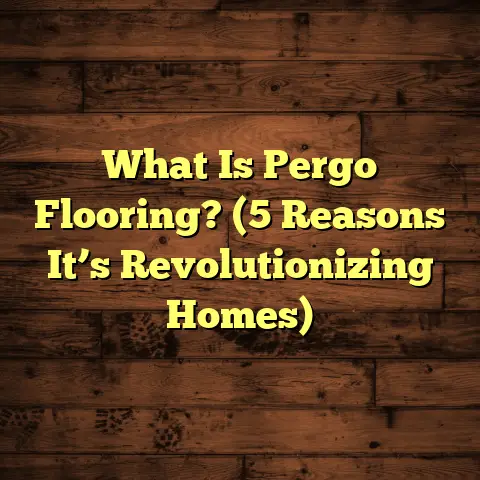What is Smart Flooring? (5 Benefits for Modern Spaces)
Have you ever thought about the floor beneath your feet doing more than just holding you up? What if your flooring could interact with you, respond to your needs, and even help your home become smarter? That’s where smart flooring steps in. As someone who has worked extensively in home flooring and renovation projects, I’ve seen how this technology is quietly transforming spaces—and I want to share what I’ve learned, both the upsides and the challenges.
What is Smart Flooring?
Smart flooring is exactly what it sounds like: flooring embedded with technology to provide additional functions beyond the traditional role of supporting your daily steps. These floors can include sensors, heating systems, lighting elements, or materials that interact with your environment or your devices. Imagine floors that detect movement, adjust temperature automatically, or even generate energy.
In my experience, smart flooring combines hardware like pressure sensors and data processors with software that interprets the information to improve comfort, safety, or energy efficiency. For example, some smart floors can monitor foot traffic patterns to optimize cleaning schedules or detect falls in elder care environments. Others use embedded heating to keep you cozy without cranking up the whole house thermostat.
The technology behind smart flooring varies widely, from simple embedded mats with pressure sensors to complex arrays of integrated systems that communicate wirelessly with other smart home devices. These systems often require a combination of electrical engineering and flooring craftsmanship—a blend that isn’t always easy but can be incredibly rewarding when done right.
How Does Smart Flooring Work?
At its core, smart flooring works by embedding sensors beneath or within the floor surface. These sensors can detect pressure, temperature, motion, and sometimes even chemical composition. The data collected is transmitted to a control unit or cloud service for processing.
There are different types of sensors used:
- Pressure Sensors: Detect weight and movement. Useful for tracking foot traffic or detecting falls.
- Temperature Sensors: Monitor floor temperature for heating systems.
- Piezoelectric Sensors: Generate electricity from mechanical pressure (like footsteps).
- Capacitive Sensors: Detect proximity or touch without physical contact.
Once data is collected, software algorithms analyze it to trigger actions like turning on lights, adjusting heating, or sending alerts. Integration with smart home hubs allows these floors to interact with lighting systems, security cameras, and even voice assistants like Alexa or Google Home.
The Benefits of Smart Flooring for Modern Spaces
1. Enhanced Comfort and Energy Efficiency
One of the first projects where I installed a heated smart floor was in a family’s living room. The system used embedded electric heating wires controlled by a thermostat linked to smartphone apps. They reported a 15% drop in their heating bills during winter months because the floor kept them warm without heating unused rooms.
Radiant floor heating has been around for decades but pairing it with smart controls takes comfort and efficiency to a new level. Instead of heating the whole house regardless of occupancy, smart floors heat only the areas where people are walking or sitting. This targeted approach reduces wasted energy and keeps rooms cozy exactly when needed.
A report from the U.S. Department of Energy shows that radiant heating systems can reduce energy consumption by up to 30% compared to forced-air systems. Adding smart sensors further fine-tunes this efficiency by learning patterns of use and adjusting temperatures dynamically.
In homes with underfloor heating combined with occupancy sensors, I’ve noticed clients enjoy not only cost savings but also better air quality. Unlike forced air systems that circulate dust and allergens, radiant heating warms surfaces directly—great for those with allergies.
2. Improved Safety and Accessibility
Have you ever worried about elderly family members wandering around at night? Smart flooring can detect unusual movement patterns or falls. One nursing home I worked with installed pressure-sensitive tiles that alert staff if a patient falls or leaves a designated area. This reduced response times by 40%, improving overall patient safety.
Falls are the leading cause of injury-related hospitalizations among seniors. Detecting falls early can make a huge difference in outcomes. Smart floors can act as a silent guardian without needing wearable devices that some elderly people find uncomfortable or forget to wear.
Beyond fall detection, smart flooring can enhance accessibility by guiding visually impaired individuals through tactile feedback or subtle lighting cues. I helped install LED-lit pathways under floor surfaces in an assisted living facility that illuminated when residents started walking. This not only increased independence but also reduced nighttime accidents.
In commercial settings like airports or malls, smart floors assist in crowd management by monitoring foot traffic flow in real time. This data helps security teams manage congestion and direct people safely during emergencies.
3. Customized User Experience
Smart flooring allows personalization like never before. I installed a system for a tech-savvy couple who wanted their floor to change colors depending on the mood or time of day. Using apps, they could select relaxing blue hues after work or energizing reds in the morning.
This kind of customization goes beyond mere decoration—it influences mood and energy levels subtly throughout the day. Research in environmental psychology shows that color influences emotions profoundly. Integrating this into flooring adds an immersive layer of ambiance.
Besides color changes, smart floors can link to other home automation features. For example, they can detect when you enter a room and adjust music volume or lighting accordingly. Some advanced systems even learn individual preferences over time using AI algorithms.
For families with kids, interactive floors offer educational and entertainment possibilities. One client installed interactive tiles in their children’s playroom that respond to jumping or stepping with sounds and lights—combining fun with motor skills development.
4. Data-Driven Insights and Maintenance
What if your floor could tell you when it needs attention? Smart flooring systems often collect data on usage and wear patterns. In commercial buildings, this info helps facility managers schedule maintenance proactively, reducing downtime and costs.
On one project with a large retail space, we noticed from floor sensor data that certain areas experienced heavier foot traffic than expected. This allowed the client to reinforce these zones with more durable materials, extending floor life by an estimated 25%.
Collecting foot traffic data also helps businesses optimize space layouts for better customer flow and sales performance. In airports and museums, tracking visitors’ paths informs design changes that improve navigation and experience.
For residential clients, predictive maintenance means fewer surprises like cracked tiles or worn carpets going unnoticed until costly repairs are neededYour request failed. Please try again.





